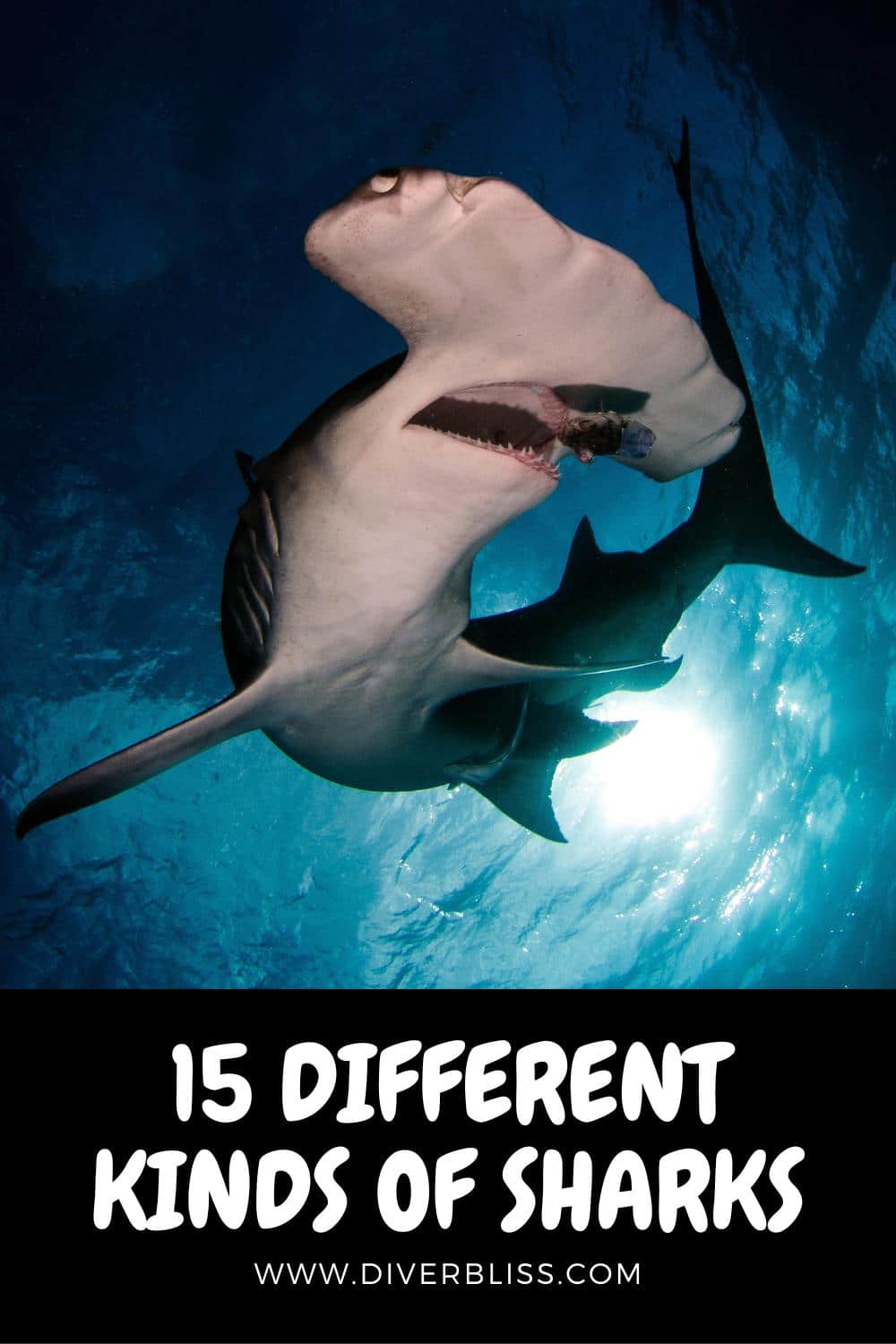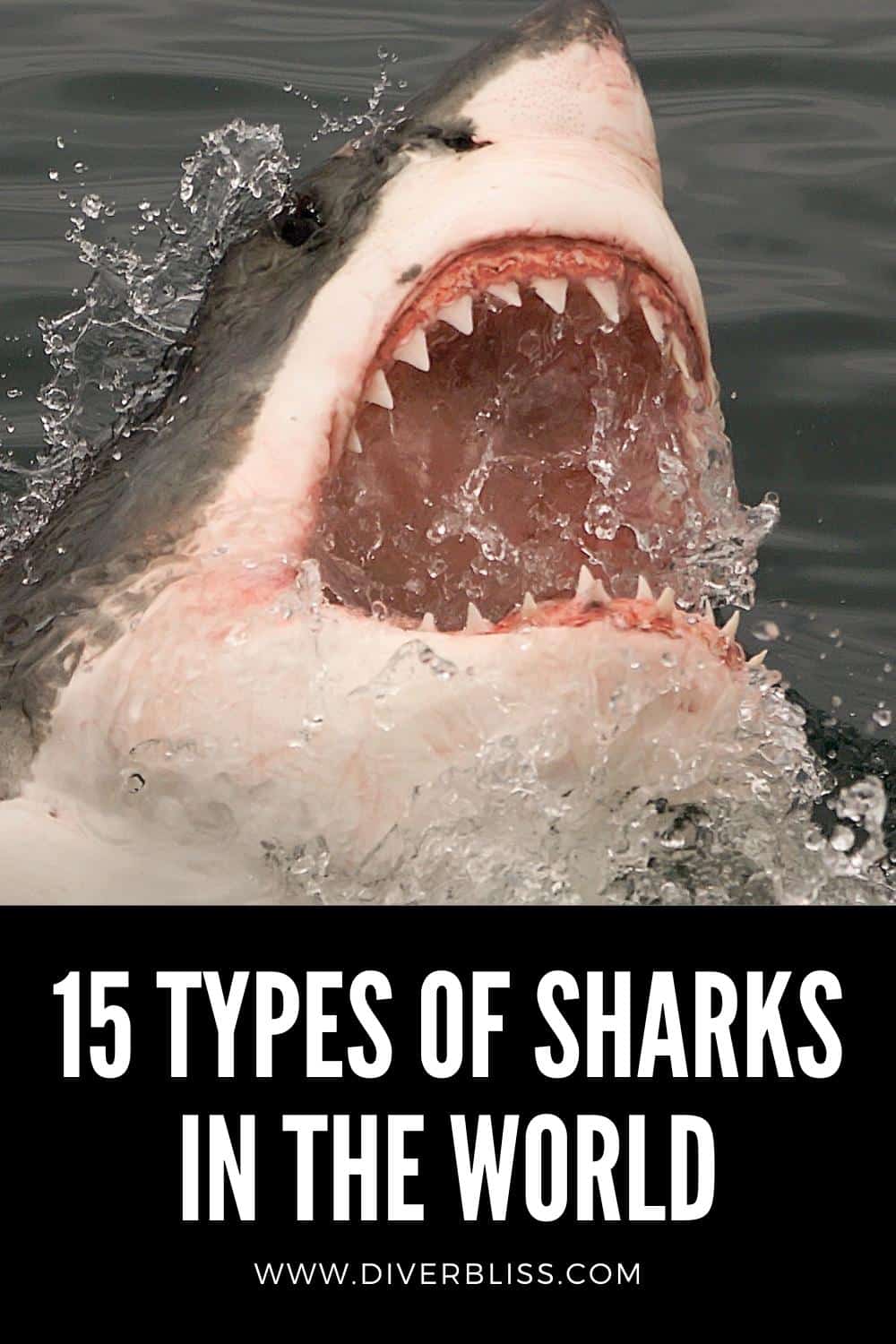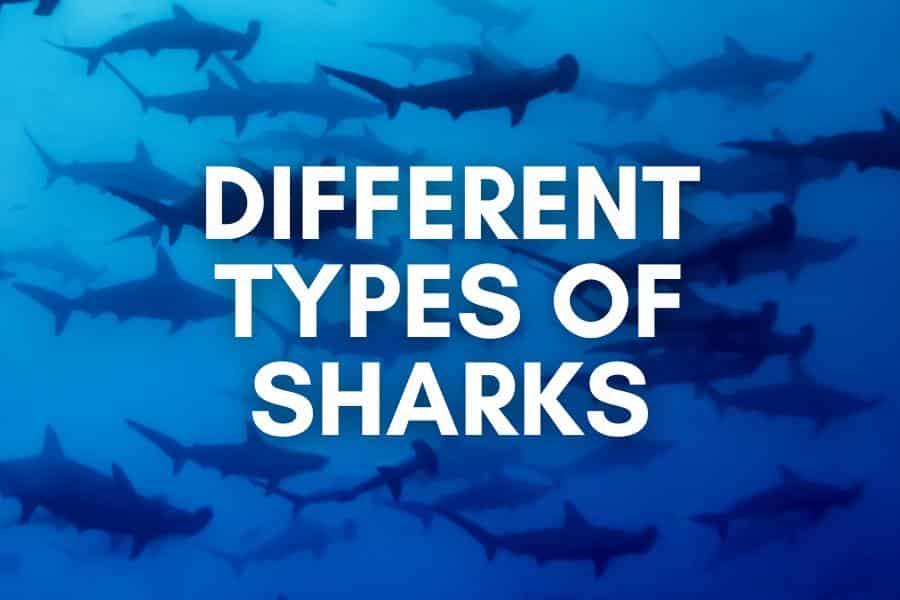Sharks are among the most famous and fascinating creatures on the planet. These powerful predators have been around for over 400 million years, making them one of the most ancient creatures on the planet.
Over 500 different shark species can be found in our ocean, ranging from freezing polar regions to warm tropical waters.
In this blog post, you will learn about the most intriguing shark species and their distinctive characteristics and behavior. From the sleek and robust great white shark to the small and elusive lanternshark, you’ll discover some interesting facts about sharks.
Whether you’re a shark fan or simply enjoy learning about different types of sharks in the world, this post is sure to have something for you.
- 1. Great white shark (Carcharodon carcharias)
- 2. Hammerhead shark (Sphyrna spp.)
- 3. Tiger shark (Galeocerdo cuvier)
- 4. Mako shark (Isurus spp.)
- 5. Bull shark (Carcharhinus leucas)
- 6. Whale shark (Rhincodon typus)
- 7. Basking shark (Cetorhinus maximus)
- 8. Thresher Sharks (Alopias spp.)
- 9. Wobbegong sharks (Orectolobidae Spp.)
- 10. Angel sharks (Squatina spp.)
- 11. Goblin shark (Mitsukurina owstoni)
- 12. Dwarf Lanternshark (Etmopterus perryi)
- 13. Viper dogfish (Trigonognathus kabeyai)
- 14. Megamouth shark (Megachasma pelagios)
- 15. Greenland shark (Somniosus microcephalus)
1. Great white shark (Carcharodon carcharias)

The great white shark (Carcharodon carcharias) is a large predatory shark found in all major oceans’ coastal waters. It is one of the most well-known and feared sharks in the world due to its powerful jaws and rows of sharp teeth.
Great white sharks can grow to be 20 feet (6 meters) long and weigh more than 5,000 pounds (2,268 kilograms). They are apex predators that eat a variety of prey, including seals, sea lions, and fish.
2. Hammerhead shark (Sphyrna spp.)
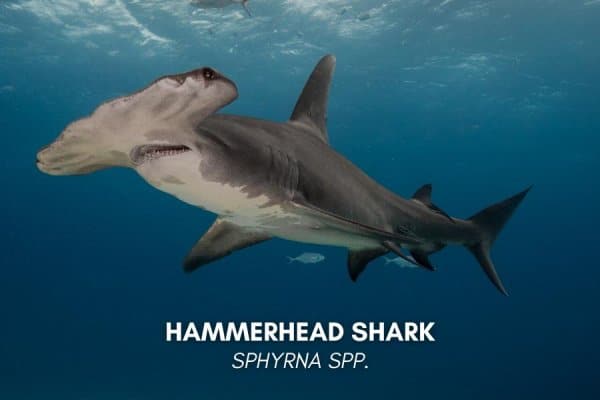
Hammerhead sharks (Sphyrna spp.) are types of sharks in the world distinguished by their distinctive hammer-shaped head. Hammerhead sharks are classified into nine species, including the great hammerhead, scalloped hammerhead, and smooth hammerhead. They can be found in tropical and warm temperate waters.
Hammerhead sharks are typically medium to large in size, with most species reaching lengths of 3-6 feet (1-2 meters). They have a varied diet, with some species feeding on small fish and crustaceans and others on larger prey such as squid and other sharks. Hammerhead sharks are known for their unusual hunting habits, swimming in circles around their prey to confuse and capture it.
Did you know that you can track hammerhead sharks? If you love the idea of being able to track these amazing creatures, Saving the Blue also has a collaboration with Fahlo where you can buy a bracelet with a real shark to track. A portion of the proceeds from The Voyage Bracelet is donated to Saving the Blue. (Use the code: DIVERBLISS20 to get a discount on your shark tracking bracelet.)
3. Tiger shark (Galeocerdo cuvier)
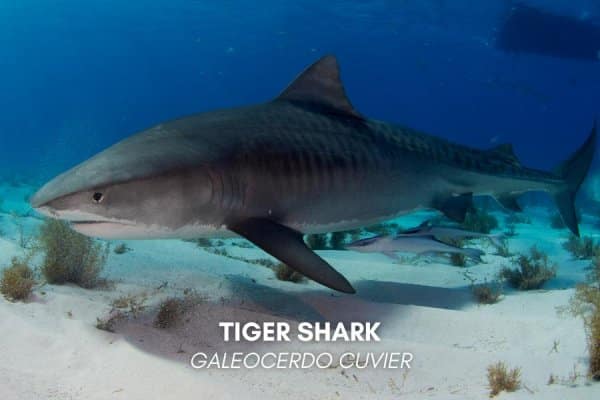
Tiger sharks (Galeocerdo cuvier) are large predatory sharks found worldwide in tropical and warm temperate waters. They get their name from the distinctive tiger-like stripes on their bodies, which fade as the shark grows and matures. Tiger sharks are aggressive predators that eat a variety of prey, including fish, seals, sea turtles, and other sharks.
Tiger sharks are generally large, with some reaching lengths of more than 20 feet (6 meters) and weighing more than 1,500 pounds (680 kilograms). Tiger sharks have been observed migrating long distances and living in various habitats, including shallow lagoons, coral reefs, and deep ocean waters.
Tiger sharks, despite their reputation as aggressive predators, are not known to pose a significant threat to humans and are not generally aggressive toward people. They have, however, been involved in a small number of human attacks and should be treated with caution if encountered in the wild. Overall, tiger sharks are an important and fascinating group of animals that deserve to be studied further.
4. Mako shark (Isurus spp.)
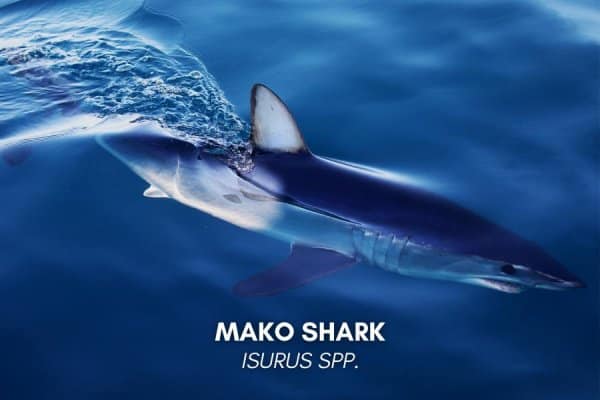
Mako sharks (Isurus spp.) are fast-swimming kinds of sharks found in temperate and tropical waters worldwide. The mako shark is divided into two species: the shortfin mako (Isurus oxyrinchus) and the longfin mako (Isurus paucus). Mako sharks have a distinct appearance due to their sleek, streamlined bodies and long, pointed snouts.
Mako sharks are typically medium to large in size, with most individuals reaching lengths of 10-15 feet (3-4.5 meters) and weighing more than 500 pounds (227 kilograms). They are fast and agile swimmers capable of reaching speeds of up to 60 miles per hour (97 kilometers per hour).
5. Bull shark (Carcharhinus leucas)
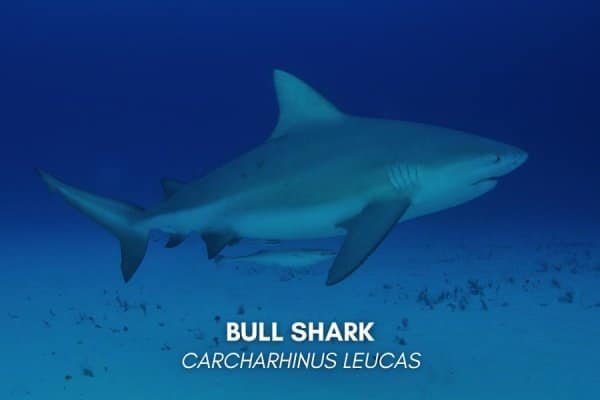
The bull shark (Carcharhinus leucas) is a large predatory shark found worldwide in tropical and warm temperate waters. It is distinguished by its stocky, muscular body and powerful jaws. Bull sharks are generally large, with most individuals reaching lengths of 6-11 feet (1.8-3.4 meters) and weighing more than 500 pounds (227 kilograms).
Bull sharks are one of the few shark species capable of surviving in both saltwater and freshwater environments. They are aggressive and have been known to attack humans, making them one of the most dangerous shark species to humans.
6. Whale shark (Rhincodon typus)
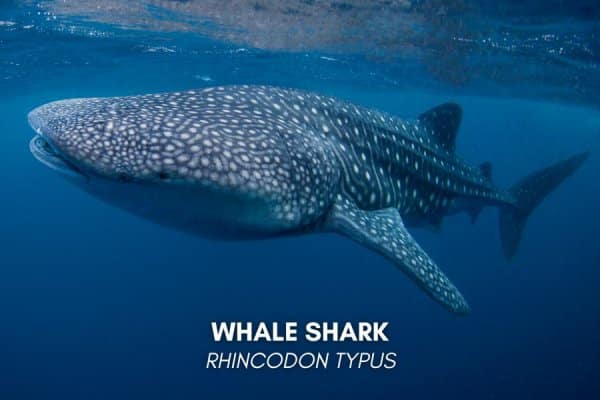
The whale shark (Rhincodon typus) is the world’s largest shark and can be found in both tropical and warm temperate waters. It is a slow-moving, filter-feeding shark that can reach lengths of more than 40 feet (12 meters) and weights more than 20 tons (18 metric tons). Despite its size, the whale shark poses no threat to humans and is generally peaceful.
Whale sharks have been observed feeding on a variety of small organisms such as plankton, krill, and small fish, which they filter from the water using their gills. Whale sharks have been observed migrating long distances to search for food and to mate.
If you love whale sharks, check out these posts:
25 Best Whale Shark Gifts You’ll Want For Yourself
10 Best Adopt a Whale Shark Programs That Protects Them
7. Basking shark (Cetorhinus maximus)

The basking shark, which can grow to be more than 30 feet (9 meters) long and weigh more than 5 tons (4.5 metric tons), is a large, slow-moving shark found worldwide in temperate and cold waters. It is the second largest shark species after the whale shark.
Despite its size, the basking shark poses no threat to humans and is generally peaceful. As a filter feeder, the basking shark eats small organisms like plankton and krill that it strains from the water with its gill rakers.
8. Thresher Sharks (Alopias spp.)
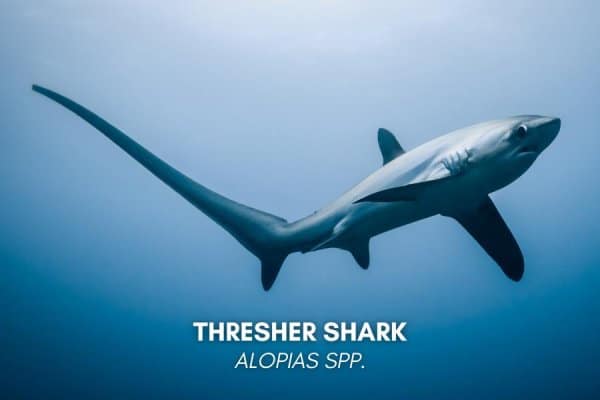
Thresher sharks, which are distinguished by their long, whip-like tails, use their tails to herd and stun prey. Thresher sharks are generally large, with most individuals reaching lengths of 10-20 feet (3-6 meters) and weights of over 500 pounds (227 kilograms).
They are also known to leap out of the water or breach in order to stun or disorient their prey.
The three species of thresher shark are the common thresher (Alopias vulpinus), bigeye thresher (Alopias superciliosus), and pelagic thresher (Alopias pelagicus).
If you want to see thresher sharks, here is a Guide to Thresher Shark Diving in Malapascua, Cebu.
9. Wobbegong sharks (Orectolobidae Spp.)
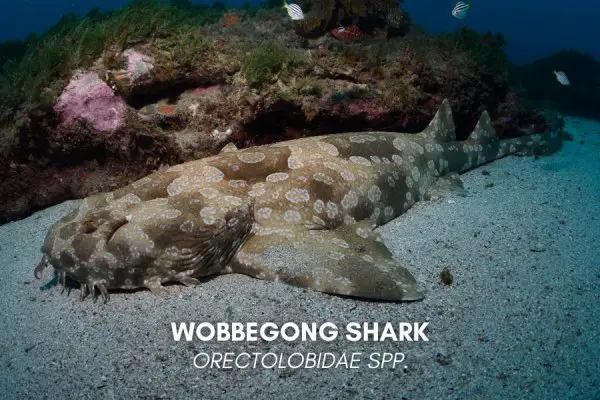
Wobbegong sharks (Orectolobidae) are a subfamily of bottom-dwelling kind of sharks in the western Pacific and Indian Oceans. There are 12 different species of wobbegong sharks, which are distinguished by their patterned skin and flattened body shape.
Wobbegong sharks are small to medium-sized, with most individuals reaching 3-10 feet (1-3 meters) in length and weighing up to 200 pounds (91 kilograms). They are ambush predators that feed on a variety of prey, including fish, squid, and other small marine animals.
10. Angel sharks (Squatina spp.)
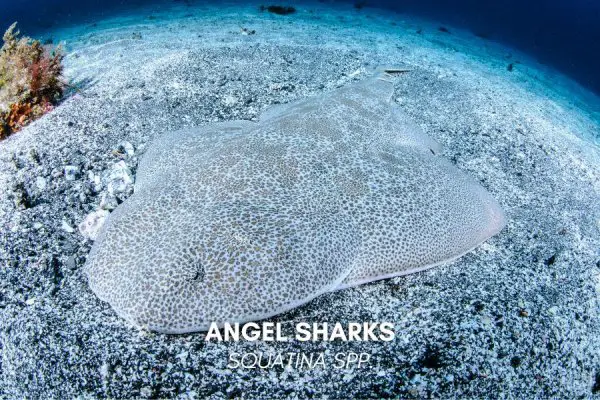
Angel sharks (Squatina spp.) are bottom-dwelling sharks found in the Atlantic and Pacific Oceans’ coastal waters. There are several species of angel sharks, which are distinguished by their flattened body shape and wing-like pectoral fins. Angel sharks are typically small to medium in size, with most reaching 3-6 feet (1-2 meters) in length and weighing up to 100 pounds (45 kilograms).
Angel sharks are generally docile and pose no significant threat to humans. They are bottom-dwelling types of sharks. You can find them in shallow coastal waters where they can hide among coral reefs and rocks.
11. Goblin shark (Mitsukurina owstoni)
The goblin shark (Mitsukurina owstoni) is a rare and unusual species of deep-sea shark. It has been found in the waters of the Pacific, Atlantic, and Indian Oceans. Goblin sharks are typically seen in deep ocean waters, at depths of over 300 feet (91 meters).
It is known for its distinctive elongated snout and protruding jaw, which are lined with long, sharp teeth. Goblin sharks are generally small to medium in size, with most individuals growing to be around 10-13 feet (3-4 meters) in length and weighing up to 300 pounds (136 kilograms).
12. Dwarf Lanternshark (Etmopterus perryi)
The dwarf lantern shark (Etmopterus perryi), which is the size of a human hand, is the smallest shark. It is a deep-sea shark that can be found in the western Atlantic Ocean. It is rare and little is known about it, having only been observed a few times at depths of more than 300 meters (1000 feet)
It belongs to the lanternshark family (Etmopteridae) and is known for its unique bioluminescent organs, which it uses to produce light and communicate with other sharks. It also has large eyes that help it see in the mostly-dark waters of the twilight zone of the ocean.
13. Viper dogfish (Trigonognathus kabeyai)
The viper dogfish (Trigonognathus kabeyai) is a small deep-sea shark found in Pacific Ocean waters. It belongs to the dogfish family (Squalidae) and is distinguished by its elongated snout and venomous spines. Most viper dogfish are small in size, growing to be around 2-3 feet (60-90 cm) in length and weighing less than 10 pounds (4.5 kilograms).
Viper dogfish can be found at depths of over 1,000 feet in deep ocean waters (300 meters). They are thought to be nocturnal predators, feeding on a variety of prey such as small fish and squid. Viper dogfish are a rare shark species that are little known to the general public.
14. Megamouth shark (Megachasma pelagios)
The megamouth shark (Megachasma pelagios) is a rare and unusual deep-sea shark that lives in the Pacific, Atlantic, and Indian Oceans. It is distinguished by its large mouth, which is lined with small, blunt teeth and is used to filter feed on small marine organisms. Megamouth sharks are generally large, with most individuals reaching lengths of 15-20 feet (4.5-6 meters) and weighing more than 1,000 pounds (454 kilograms).
15. Greenland shark (Somniosus microcephalus)
The Greenland shark (Somniosus microcephalus) is a large, deep-dwelling shark found in the North Atlantic Ocean’s cold waters. It is also known as the “gray shark” or the “sleeper shark” due to its slow swimming style and sluggish behavior. Greenland sharks are generally large, with most individuals reaching lengths of 15-20 feet (4.5-6 meters) and weighing more than 1,000 pounds (454 kilograms). These sharks are thought to live for 400 years or more.
Sharks are a diverse and fascinating group of animals that have captured people’s attention for centuries. You can help to ensure the long-term health and vitality of our oceans by protecting sharks and their habitats. One way you can help is by symbolically adopting a shark.
As you learn more about these creatures, it is critical to remember the importance of sharks in maintaining the balance of marine ecosystems and working toward their conservation.
If you love sharks or know someone who does, check out these posts
33 Best Shark Gifts That Are Totally Jaw-some!
15 Outstanding Shark Conservation Groups You Can Support
Got Pinterest? Save this for later!
